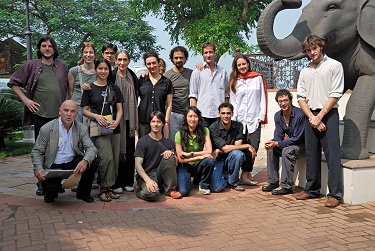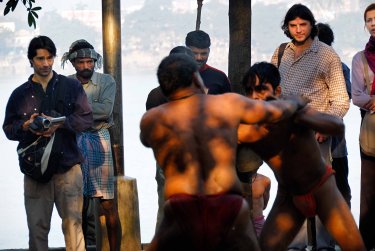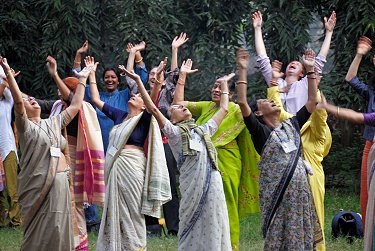 |
  |
 |
  |
| Tribute / interview
Pina Bausch: A legendary dancer, choreographer passes away - Dr. Sunil Kothari e-mail: sunilkothari1933@gmail.com Photos courtesy: Martin Waelde July 9, 2009 When Pina Bausch visited India in November 2006, to work on her India piece, it created quite an excitement. People remembered that they had seen her in India with her creation 'Carnation' in the year 1994. Her latest work titled 'Bamboo Blues,' inspired from images of India, was presented at the Siri Auditorium as a part of the 10th Bharat Rang Mahotsav, during the Golden Jubilee celebrations of the National School of Drama in January 2008. Besides New Delhi, Pina Bausch also toured Mumbai and Kolkata. Under the new initiative of National School of Drama's archives project, an interview with Pina Bausch was planned. I was invited by National School of Drama to interview her on January 4th at NSD's studio. Whoever has been lucky to witness any of the productions of Pina Bausch's Tanztheatre - dance theatre - can never forget the images one sees on the stage. When audiences saw hundreds of carnations planted on the stage at Rabindra Sadan in 1994 in Kolkata, they were amazed at the scale and dimension of the field. Succession of the images assault our senses, sometimes connected, sometimes not connected. One was also reminded of the Democratic Youth Federation's protest against the staging of Stravinsky's 'The Rites of Spring,' when young leader Buddhadev Bhattacharya (now the present Chief Minister of Left Government in West Bengal) had succeeded in stopping the performance in Kolkata, way back in early '70s, on the grounds that the nude display of human body was against our Indian culture! Not that Pina Bausch wanted ever to hurt the sentiments and feelings of Indian people. Today Pina Bausch's works have been accepted with deep understanding and respect. At the invitation of Max Mueller Bhavan, in 2006, Pina Bausch visited Kolkata and Kerala to collect material for her collaborative new work. Her love for India had deepened over the years. In the year 1995 during the Avignon Festival in France, with focus on India, she attended most of the performances by great gurus Kelucharan Mahapatra (Odissi), Vempati Chinna Satyam, (Kuchipudi), 'Mahakal' choreographic work of Chandralekha, saw 'Chakravyuha' production of Ratan Thiyam and met Indian dancers, actors at leisure, savoring the classical dance and music. She had interacted with Chandralekha and both the choreographers from different backgrounds were linked by their firm commitment to a new dance language. Without wanting to learn intricacies of classical Indian dance forms, Pina Bausch, with her visits to India wished 'to pick up certain things from reality, little details, so many things, opposite things, some very painful, difficult to explain' and had decided to keep doors open. She is known for linking dichotomous elements. In her works, there is an assemblage of the brutal, beautiful and ridiculous, juxtaposition of humour, tragedy, agony, alienation in quite a disturbing manner. No explanations are offered and her dance theatre defies definition or category. Reactions can vary from viewer to viewer. But one is compelled to react. William Forsythe, the choreographer, has said: "She has basically re-invented dance. She is one of the greatest innovators of the past 50 years. She needs to examine the world this way. She is a category of dance unto herself. Dance-theatre didn't exist before she invented it."     Excerpts from the interview: Sunil Kothari: To begin with, welcome to India. It was a pleasure to attend the silver jubilee celebrations in 1998, at Wuppertal in Germany, where your company is based. We would like to know about how you began your career as a dancer. Let us know about your family background. Pina Bausch: My father was a proprietor of a small hotel and a restaurant. My brother Roland and sister Anita were older than me by ten years. So I was left alone always around the restaurant till very late, sitting under a table somewhere. I was constantly dancing. The performers from local Solingen Theatre and, people from chorus used to come for eating to the restaurant. They were amused to watch me. Since I was hopping and doing handstands, they suggested I should go to children's ballet. I used to lie on my stomach, bring legs near my head and they would say: 'Are you are a snake person or a contortionist?' At 14, I won a place at Folkwang Ballet at Essen. Kurt Jooss, the father of German Expressionist dance, which combined movement, music and dramatic elements was the director there. The painters, sculptors, designers, photographers, all used to visit the school. So it was different from a little ballet school. Yes, there was Donya Feuer, who took me under her wings. Sunil Kothari: In 1958 when you were 18, you joined the Julliard School in New York. Pina Bausch: Yes, I was under the care of a renowned ballerina. But I was feeling very lonely and used to cry a lot, feeling insecure and intimidated. But my radiance as a dancer impressed Martha Graham, disciples like Louise Horst, Mary Hinkson and Jose Limon. At that time, Antony Tudor became a member of Metropolitan Opera Ballet Company. There were Paul Taylor and Paul Sanasardo also on the scene. Sunil Kothari: That must have been a wonderful period, full of creativity. Pina Bausch: Yes, in 1961, 'Phases of Madness' solos, evening length ballet 'View of God,' Tudor's solo '500 Arabesques' were highlights of the season. Critics wrote that I used to dance on point, with lyrical flexibility and tremendous intensity. But you know I was very thin, unwell, and could not eat. And after some time I wanted to go back to Germany. Kurt Jooss asked me to leave USA. I returned and got better quite quickly. I did several solos. Then in 1968, Kurt Jooss left. So I was asked to become the director of Folkwang Tanzstudio. Sunil Kothari: When did you start choreographing? Pina Bausch: I did not want to be a choreographer. I wanted to express myself differently and dance. I did not want to imitate anybody. Sunil Kothari: When did you move to Wuppertal? Pina Bausch: In 1973, I was offered directorship of Wuppertal Ballet. In the beginning I was reluctant to go there as it is a provincial town, and very conservative. Sunil Kothari: Please tell us about the few startling and unpleasant experiences you had at that time. Pina Bausch: Well, let me see. Few experiences... OK. My first production 'Fritz' was considered outlandish. There was disbelief and also open hostility, and you will not believe, people threw oranges, banged the doors. My dancers from the audience came on stage, picked up a bucket of water and when a dancer ducked her head, water spilled over the audience.... this was all shocking for the audience. Sunil Kothari: Besides dance you have collaborated with dance operas. Pina Bausch: The dance operas I worked for were 'Iphigenie and Tairis' - Orpheus and Eurydice. The last was in the year1975. Sunil Kothari: We have very strong memories of 'The Rite of Spring.' The violence and the rituals... Pina Bausch: In 'The Rite of Spring,' I had depicted the ritualistic battle of sexes, sacrifice by symbolic use of red dress performed on layer of topsoil, incantatory movements into dirt, panting audibly throughout. Sunil Kothari: In 'Seven Deadly Scenes' you have precisely choreographed gang rape scene. You appear such a gentle soul, in appearance and demeanor. How come there is so much violence in the presentation of your work? Pina Bausch: Difficult to explain. I am against violence. But I have to understand the nature of violence. What makes people turn so violent? I am often misunderstood.... While listening to a taped recording of Bela Bartok's Duke Bluebeard's Castle, Blaubart brutally almost casually rapes his wife, and repeatedly shoves her head into his crotch in a deeply disturbing scene of ritual humiliation. I am terrified of violence but I wanted to understand the person doing violence, and that was the exploration in my work....' She trails off. There is silence. When Pina Bausch works on a new production there is a Q and A format. The dancers get up; dance the question, solo, with a partner, or a prop, no answer comes from Pina when she choreographs. She refuses to discuss the work explicitly in rehearsals and never reveals underlying themes or possible future directions. It is like a big secret existing inside her. It forms the basis of subsequent work. While working with her, some dancers were battered and emotionally brutalized. I had read that in 'Come dance with me,' an exploration of sexual conflict loosely structured around traditional German folk song, Pina had attempted deconstruction of gender stereotypes: amazing, weird, brutal sick kind of things, breakdown, crying, like rape, groping dancers in six different ways and kissing. One of the dancers Jo Ann Endicott has gone on record saying that "we felt naked and exposed." Meryl Tankard, one of Pina Bausch's dancers and a choreographer now in Melbourne, broke down crying while rehearsing with Pina's dancers. Sunil Kothari: In 1973-74 Cafe Muller, you danced hurtling yourself against the wall. I saw it for the first time in Venice and have a strong memory of it. Pina Bausch: Oh, that work has become well known. But I moved further away from there. The trajectory of Pina Bausch's work is fantastic. It ended with spectacular visual effects: she employed Arias, the dancers, sodden, splash though a pool, inhabited by a wallowing hippopotamus. In 'Legend of Chastity' armchairs on actors, life-size alligators crawl across the stage. Sunil Kothari: By 1980, your work is steadily more joyous and celebratory. In 1995 in Cuban dance 'Danzon,' you danced after a decade. You give credit to the young members of the company for your choreographic works. Pina Bausch: It is a collaborative work. It is well known that in 1982, Pina Bausch performed in Federico Fellini's film 'And the Ship Sails On' and in 1990 she directed the film 'The Complaint of an Empress.' Pina Bausch's other well known dance theatre productions are: 'Viktor' - a co-production with Teatro Argentina / Rome (1986) 'Palermo Palermo' (1989) 'Nur Du' (only you), inspired by the American West and California in particular (1996) Her works have travelled to Istanbul, Korea, Japan. Critics objected to the darkness and violence in the works of Pina Bausch. She says: "One thing has not changed. Lacerating self- doubt. At this point, I do not know anything. I just cannot hope. I feel my way, and try not to be afraid, it is just not that the dancers do not know where they are going, I also do not know ..I have to trust myself." Through her work, Pina Bausch always sought to discover and articulate a universal grammar of human existence that transcends local cultures. She studied various cultures, constantly changing, captivating images of human emotions: anger, fear, love, rendered in an ironic and poetic manner. The dancers portrayed their own experiences and cultural codes on stage; the images transcended language barriers and conveyed universal understanding. She passed away on 30th June 2009. She was suffering from cancer. Doubtless she was one of the greatest dancers and choreographers.  Dr. Sunil Kothari, dance historian, scholar, author, is a renowned dance critic, having written for The Times of India group of publications for more than 40 years. He is a regular contributor to Dance Magazine, New York. Dr. Kothari is a globetrotter, attending several national, international dance conferences and dance festivals. He has to his credit more than 14 definitive works on Indian classical dance forms. Kothari was a Fulbright Professor and has taught at the Dance Department, New York University; has lectured at several Universities in USA, UK, France, Australia, Indonesia and Japan. He has been Vice President of World Dance Alliance Asia Pacific (2000-2008) and is Vice President of World Dance Alliance Asia Pacific India chapter, based in New Delhi. A regular contributor to www.narthaki.com, Dr Kothari is honored by the President of India with the civil honor of Padma Shri and Sangeet Natak Akademi award. |